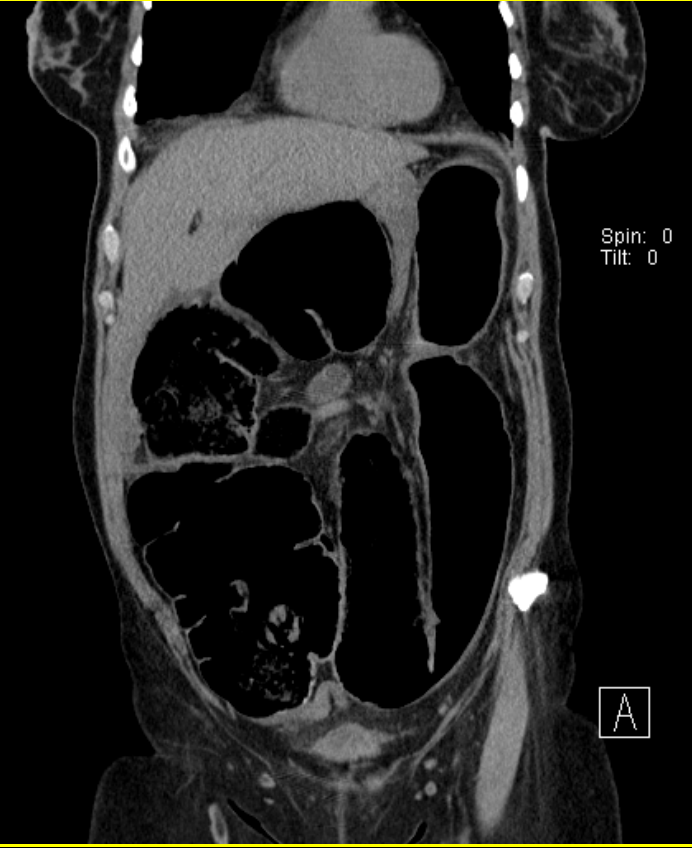[1]
Pisano M, Zorcolo L, Merli C, Cimbanassi S, Poiasina E, Ceresoli M, Agresta F, Allievi N, Bellanova G, Coccolini F, Coy C, Fugazzola P, Martinez CA, Montori G, Paolillo C, Penachim TJ, Pereira B, Reis T, Restivo A, Rezende-Neto J, Sartelli M, Valentino M, Abu-Zidan FM, Ashkenazi I, Bala M, Chiara O, De' Angelis N, Deidda S, De Simone B, Di Saverio S, Finotti E, Kenji I, Moore E, Wexner S, Biffl W, Coimbra R, Guttadauro A, Leppäniemi A, Maier R, Magnone S, Mefire AC, Peitzmann A, Sakakushev B, Sugrue M, Viale P, Weber D, Kashuk J, Fraga GP, Kluger I, Catena F, Ansaloni L. 2017 WSES guidelines on colon and rectal cancer emergencies: obstruction and perforation. World journal of emergency surgery : WJES. 2018:13():36. doi: 10.1186/s13017-018-0192-3. Epub 2018 Aug 13
[PubMed PMID: 30123315]
[2]
Toumi O, Hamida B, Njima M, Bouchrika A, Ammar H, Daldoul A, Zaied S, Ben Jabra S, Gupta R, Noomen F, Zouari K. Adenosquamous carcinoma of the right colon: A case report and review of the literature. International journal of surgery case reports. 2018:50():119-121. doi: 10.1016/j.ijscr.2018.07.001. Epub 2018 Jul 11
[PubMed PMID: 30103094]
Level 3 (low-level) evidence
[3]
Quinn K, Davis ME, Carter L, Shortell CK, Sommer C. Emergency General Surgery-A Misnomer? The American surgeon. 2018 Jul 1:84(7):1214-1216
[PubMed PMID: 30064591]
[4]
De Monti M, Cestaro G, Alkayyali S, Galafassi J, Fasolini F. Gallstone ileus: A possible cause of bowel obstruction in the elderly population. International journal of surgery case reports. 2018:43():18-20. doi: 10.1016/j.ijscr.2018.01.010. Epub 2018 Feb 4
[PubMed PMID: 29414501]
Level 3 (low-level) evidence
[5]
Shah D, Makharia GK, Ghoshal UC, Varma S, Ahuja V, Hutfless S. Burden of gastrointestinal and liver diseases in India, 1990-2016. Indian journal of gastroenterology : official journal of the Indian Society of Gastroenterology. 2018 Sep:37(5):439-445. doi: 10.1007/s12664-018-0892-3. Epub 2018 Oct 10
[PubMed PMID: 30306342]
[6]
Doshi R, Desai J, Shah Y, Decter D, Doshi S. Incidence, features, in-hospital outcomes and predictors of in-hospital mortality associated with toxic megacolon hospitalizations in the United States. Internal and emergency medicine. 2018 Sep:13(6):881-887. doi: 10.1007/s11739-018-1889-8. Epub 2018 Jun 12
[PubMed PMID: 29948833]
[7]
Cinar H, Berkesoglu M, Derebey M, Karadeniz E, Yildirim C, Karabulut K, Kesicioglu T, Erzurumlu K. Surgical management of anorectal foreign bodies. Nigerian journal of clinical practice. 2018 Jun:21(6):721-725. doi: 10.4103/njcp.njcp_172_17. Epub
[PubMed PMID: 29888718]
[8]
Orgul G, Soyer T, Yurdakok M, Beksac MS. Evaluation of pre- and postnatally diagnosed gastrointestinal tract obstructions. The journal of maternal-fetal & neonatal medicine : the official journal of the European Association of Perinatal Medicine, the Federation of Asia and Oceania Perinatal Societies, the International Society of Perinatal Obstetricians. 2019 Oct:32(19):3215-3220. doi: 10.1080/14767058.2018.1460350. Epub 2018 Apr 12
[PubMed PMID: 29606013]
[9]
Syrmis W, Richard R, Jenkins-Marsh S, Chia SC, Good P. Oral water soluble contrast for malignant bowel obstruction. The Cochrane database of systematic reviews. 2018 Mar 7:3(3):CD012014. doi: 10.1002/14651858.CD012014.pub2. Epub 2018 Mar 7
[PubMed PMID: 29513393]
Level 1 (high-level) evidence
[10]
Farkas N, Kaur V, Shanmuganandan A, Black J, Redon C, Frampton AE, West N. A systematic review of gallstone sigmoid ileus management. Annals of medicine and surgery (2012). 2018 Mar:27():32-39. doi: 10.1016/j.amsu.2018.01.004. Epub 2018 Jan 31
[PubMed PMID: 29511540]
Level 1 (high-level) evidence
[11]
Di Saverio S, Birindelli A, Segalini E, Novello M, Larocca A, Ferrara F, Binda GA, Bassi M. "To stent or not to stent?": immediate emergency surgery with laparoscopic radical colectomy with CME and primary anastomosis is feasible for obstructing left colon carcinoma. Surgical endoscopy. 2018 Apr:32(4):2151-2155. doi: 10.1007/s00464-017-5763-y. Epub 2017 Aug 8
[PubMed PMID: 28791424]
[12]
Utomo B, Alvarez C, Baldonedo RF. Management of Colorectal Cancer Patients Undergoing a Colonic Stenting: A Multidisciplinary Team Approach. Gastroenterology nursing : the official journal of the Society of Gastroenterology Nurses and Associates. 2017 Sep/Oct:40(5):342-349. doi: 10.1097/SGA.0000000000000255. Epub
[PubMed PMID: 28957966]
[13]
Costa G, Ruscelli P, Balducci G, Buccoliero F, Lorenzon L, Frezza B, Chirletti P, Stagnitti F, Miniello S, Stella F. Clinical strategies for the management of intestinal obstruction and pseudo-obstruction. A Delphi Consensus study of SICUT (Società Italiana di Chirurgia d'Urgenza e del Trauma). Annali italiani di chirurgia. 2016:87():105-17
[PubMed PMID: 27179226]
Level 3 (low-level) evidence
[14]
Matsuda A, Miyashita M, Matsumoto S, Sakurazawa N, Kawano Y, Yamahatsu K, Sekiguchi K, Yamada M, Hatori T, Yoshida H. Colonic stent-induced mechanical compression may suppress cancer cell proliferation in malignant large bowel obstruction. Surgical endoscopy. 2019 Apr:33(4):1290-1297. doi: 10.1007/s00464-018-6411-x. Epub 2018 Aug 31
[PubMed PMID: 30171397]

